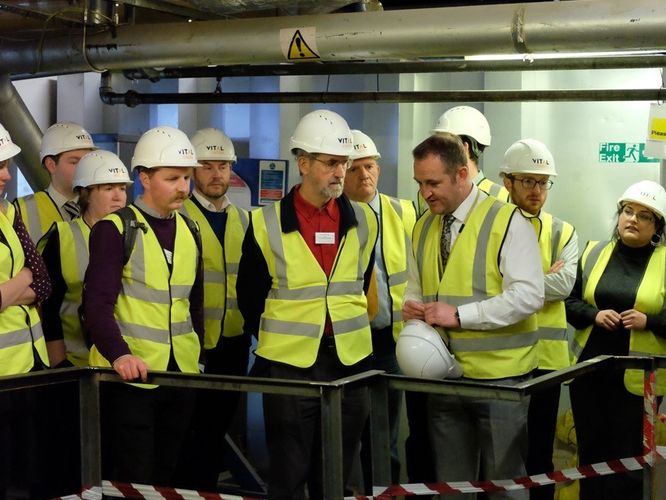District heating networks could be the low carbon energy supply solution that...
District heating networks could be the low carbon energy supply solution that helps universities to cut their energy bills and meet their carbon targets.
Over twenty universities and colleges from all over Britain attended the district heating networks seminar for universities and colleges organised by the EAUC and held at the Danish Embassy in London on 28 April 2016. The seminar was followed by a site visit to the new energy centre at Imperial College London, who kindly showed the group around the works being done to install a brand new heating network at the university and explained the benefits and challenges that the installation presents.
The seminar featured several expert speakers on district heating from both the UK and Denmark. The person leading the work of the Department of Energy and Climate Change on low carbon heat networks (district heating) set out how Government was backing their installation of with £300 million of investment to help the UK reach its carbon targets. A team from Salix Finance described how their fund has helped universities and colleges to run carbon reduction projects, including the installation of efficient combined heat and power systems (CHP).
David Somervell, the former head of sustainability at the University of Edinburgh, showed how he had cut energy costs and carbon emissions by installing CHP engines and linking the campus buildings with their own heat pipe network. The managing director of a Danish pipe manufacturer, Isoplus, described how his company had supplied several kilometres of highly insulated pipe to the University of St Andrew's biomass project, helping the university save 6,000 tonnes of CO2. Accurate metering of individual buildings pays dividends in controlling the fuel costs of your campus heat networks, was the message of the MD of ista, a metering and billing company. The advisor on energy at the Embassy described how over 60 percent of Danish buildings were connected to district heating, with Denmark being well on the way to being zero carbon. Finally, the a director of Vital Energi set out how his team had installed two large CHP engines in legacy buildings on the crowded Imperial College London campus, giving useful background information for the tour later in the day.
According to the Carbon Trust, the annual energy costs for the Further and Higher Education (FHE) sector in the UK are around £400 million, resulting in CO2 emissions of around 3 million tonnes per year. The seminar explained how generating your own energy through CHP and biomass and installing heat district heating networks can be a cost-effective way to reduce energy bills and carbon emissions. At least 59 out of the UK’s 161 universities already have CHP-based systems installed.
The event was free to attend for EAUC members. For more information contact Stephen Tulip (EAUC) stulip@eauc.org.uk or Ian Manders (Danish Embassy) ianman@um.dk
Over twenty universities and colleges from all over Britain attended the district heating networks seminar for universities and colleges organised by the EAUC and held at the Danish Embassy in London on 28 April 2016. The seminar was followed by a site visit to the new energy centre at Imperial College London, who kindly showed the group around the works being done to install a brand new heating network at the university and explained the benefits and challenges that the installation presents.
The seminar featured several expert speakers on district heating from both the UK and Denmark. The person leading the work of the Department of Energy and Climate Change on low carbon heat networks (district heating) set out how Government was backing their installation of with £300 million of investment to help the UK reach its carbon targets. A team from Salix Finance described how their fund has helped universities and colleges to run carbon reduction projects, including the installation of efficient combined heat and power systems (CHP).
David Somervell, the former head of sustainability at the University of Edinburgh, showed how he had cut energy costs and carbon emissions by installing CHP engines and linking the campus buildings with their own heat pipe network. The managing director of a Danish pipe manufacturer, Isoplus, described how his company had supplied several kilometres of highly insulated pipe to the University of St Andrew's biomass project, helping the university save 6,000 tonnes of CO2. Accurate metering of individual buildings pays dividends in controlling the fuel costs of your campus heat networks, was the message of the MD of ista, a metering and billing company. The advisor on energy at the Embassy described how over 60 percent of Danish buildings were connected to district heating, with Denmark being well on the way to being zero carbon. Finally, the a director of Vital Energi set out how his team had installed two large CHP engines in legacy buildings on the crowded Imperial College London campus, giving useful background information for the tour later in the day.
According to the Carbon Trust, the annual energy costs for the Further and Higher Education (FHE) sector in the UK are around £400 million, resulting in CO2 emissions of around 3 million tonnes per year. The seminar explained how generating your own energy through CHP and biomass and installing heat district heating networks can be a cost-effective way to reduce energy bills and carbon emissions. At least 59 out of the UK’s 161 universities already have CHP-based systems installed.
The event was free to attend for EAUC members. For more information contact Stephen Tulip (EAUC) stulip@eauc.org.uk or Ian Manders (Danish Embassy) ianman@um.dk











